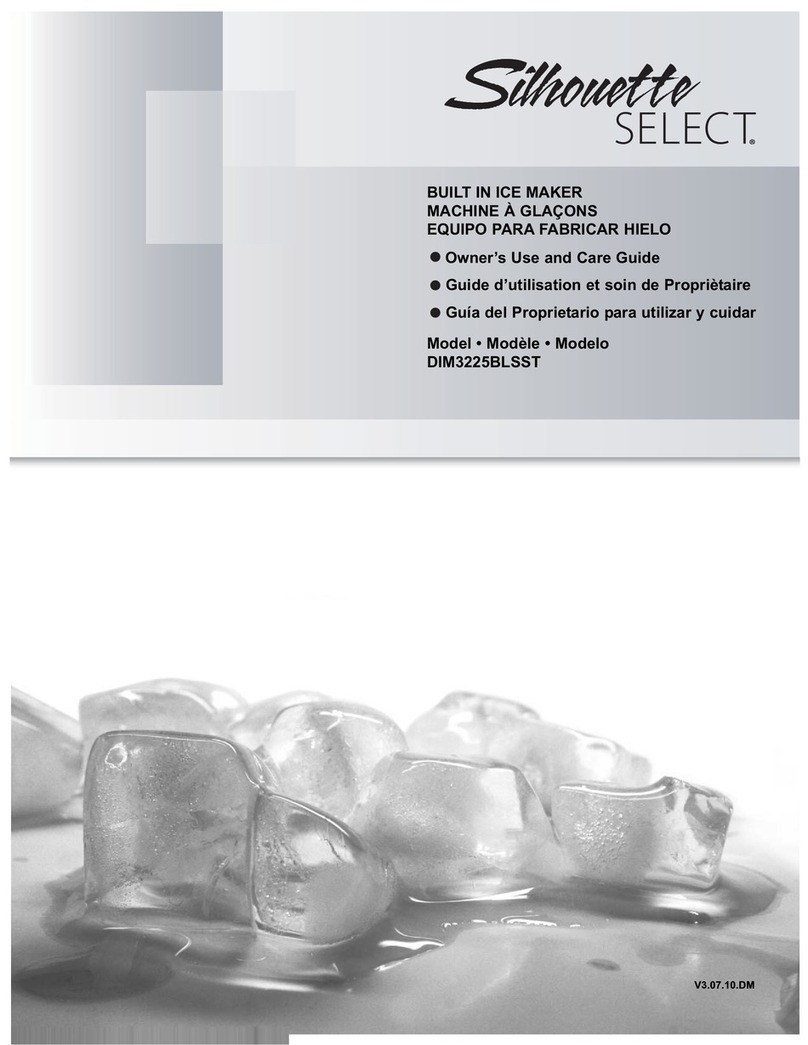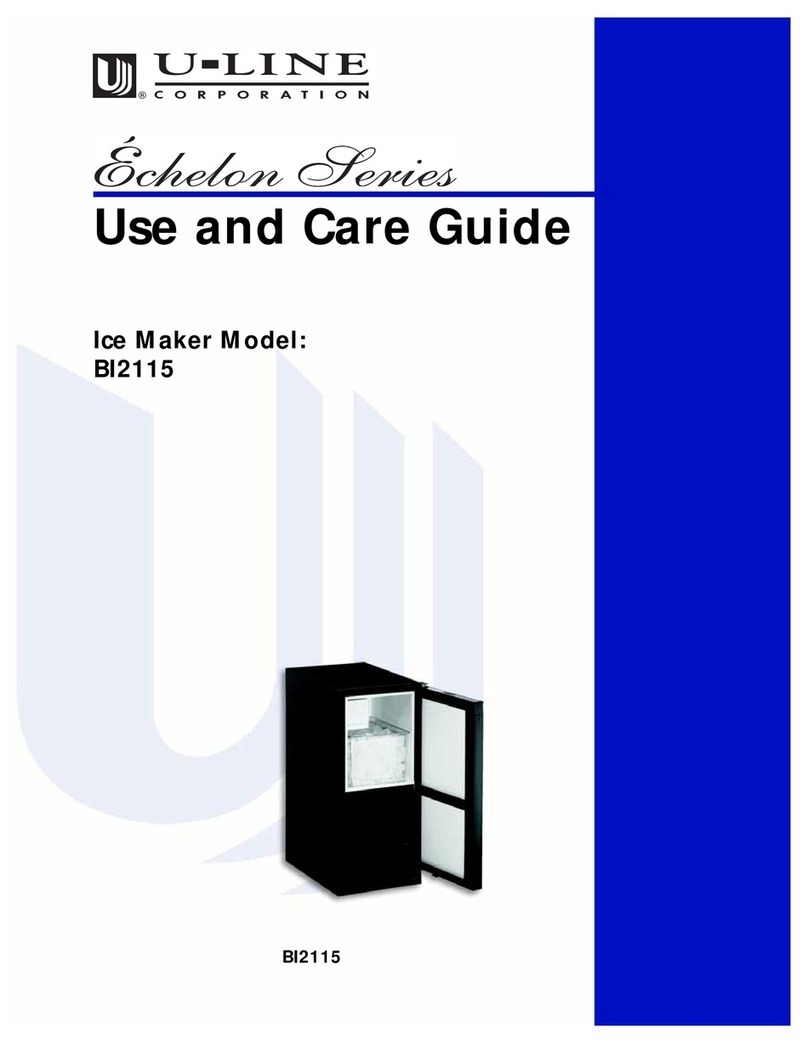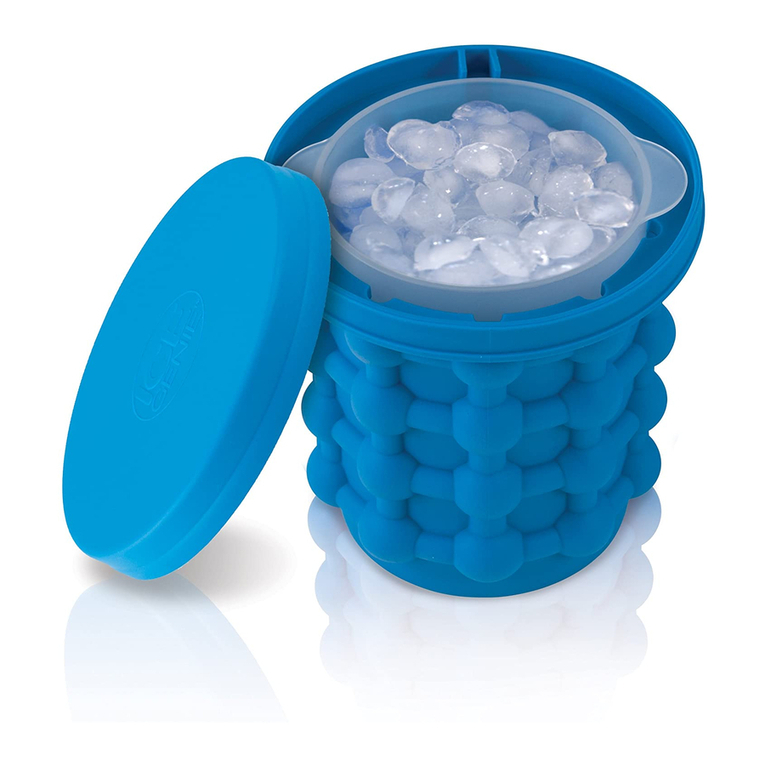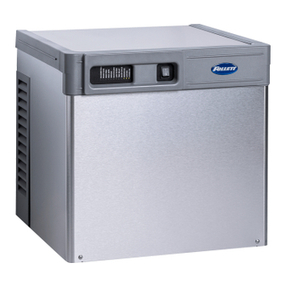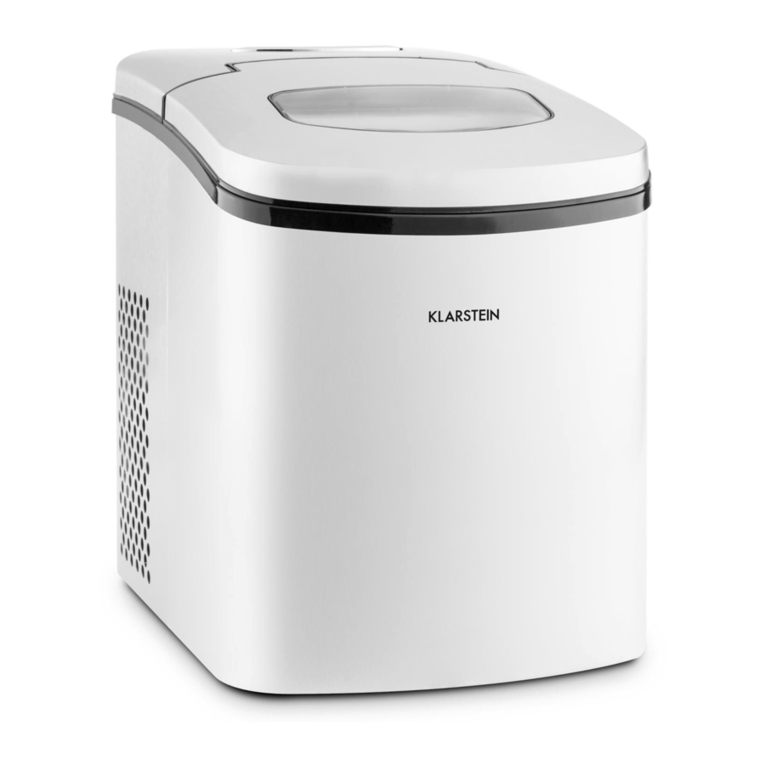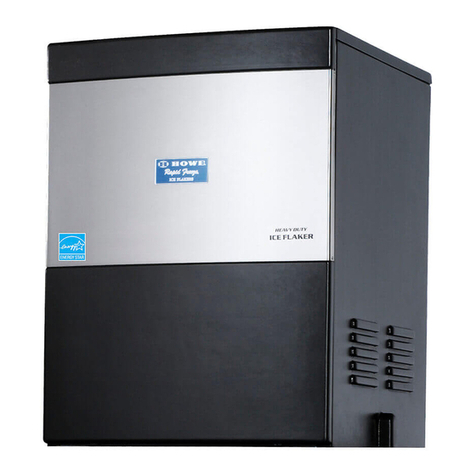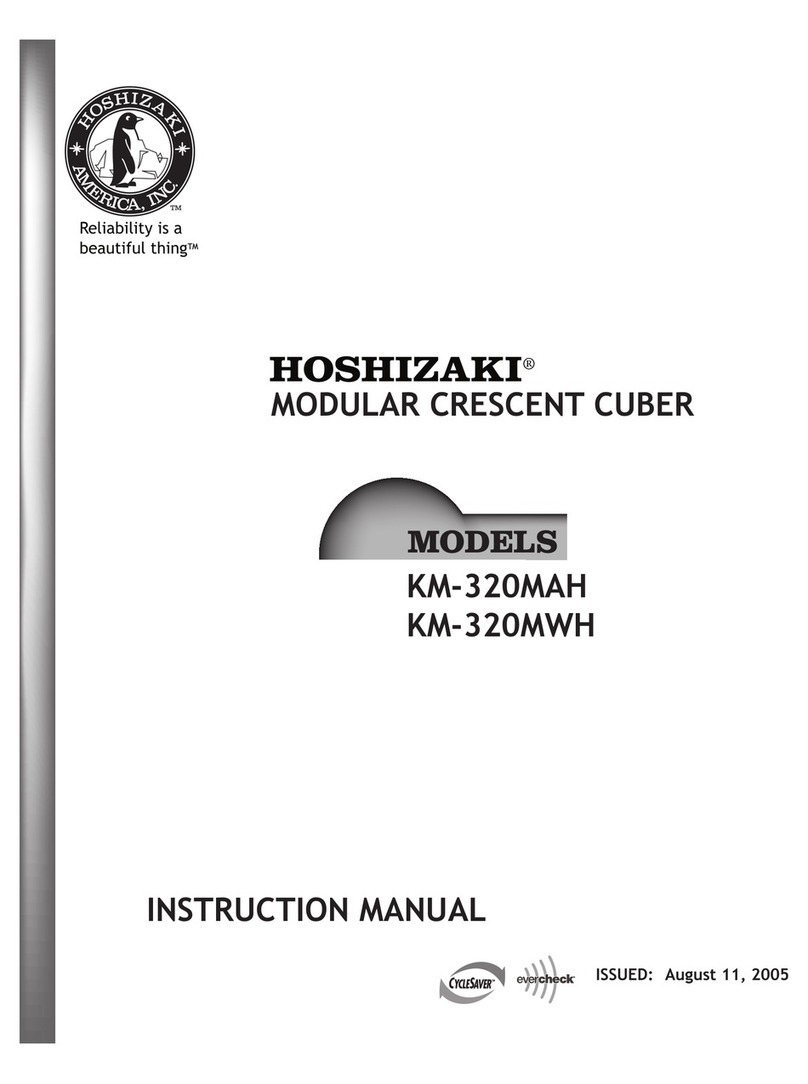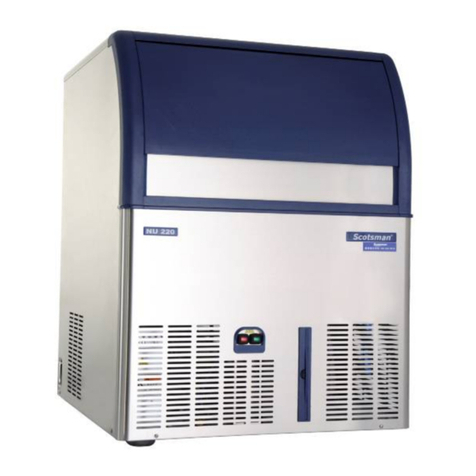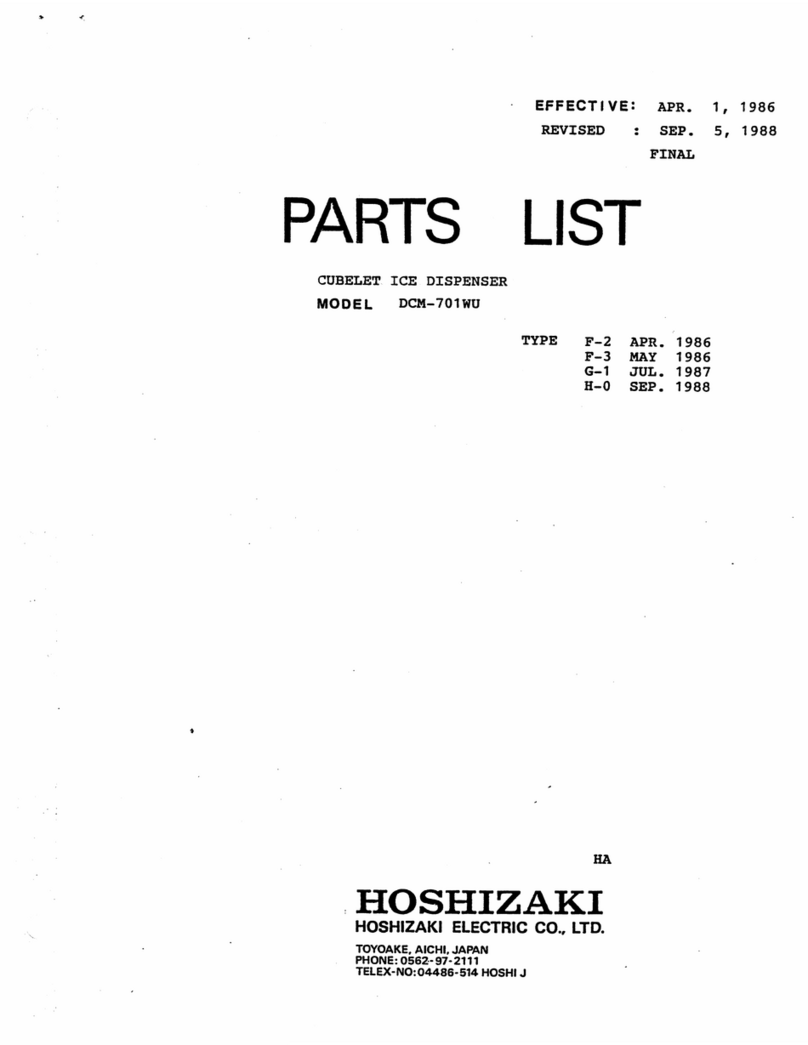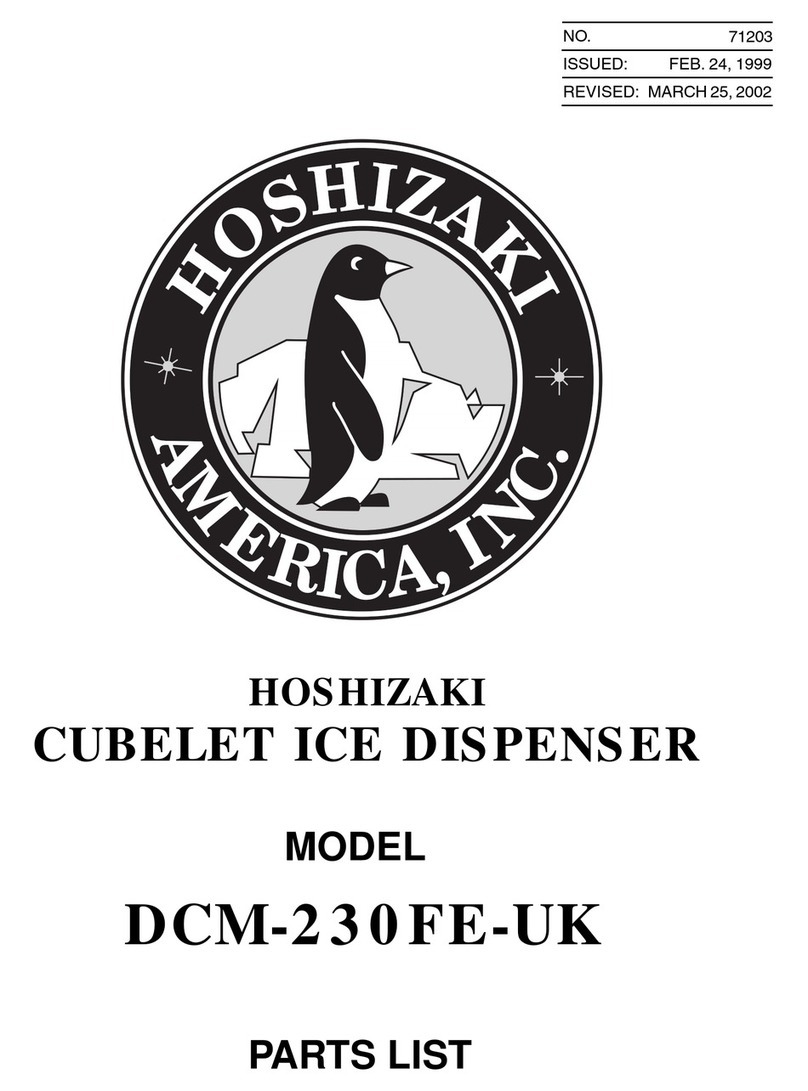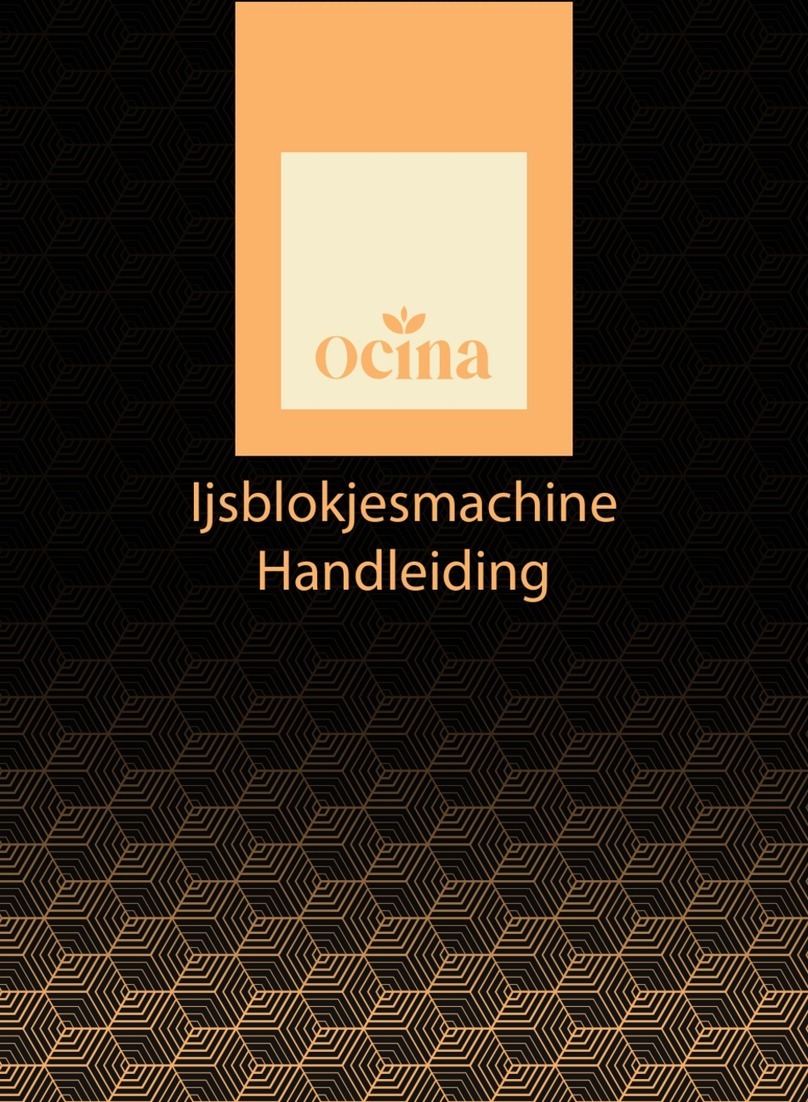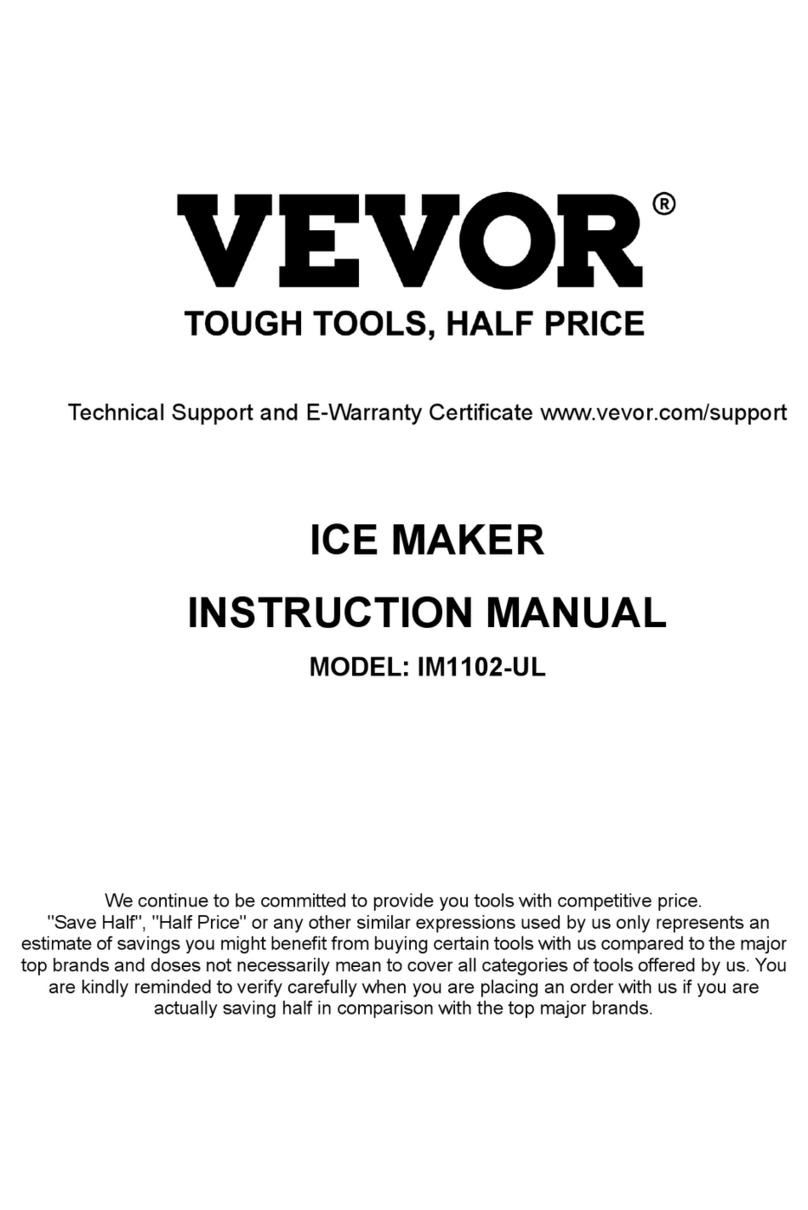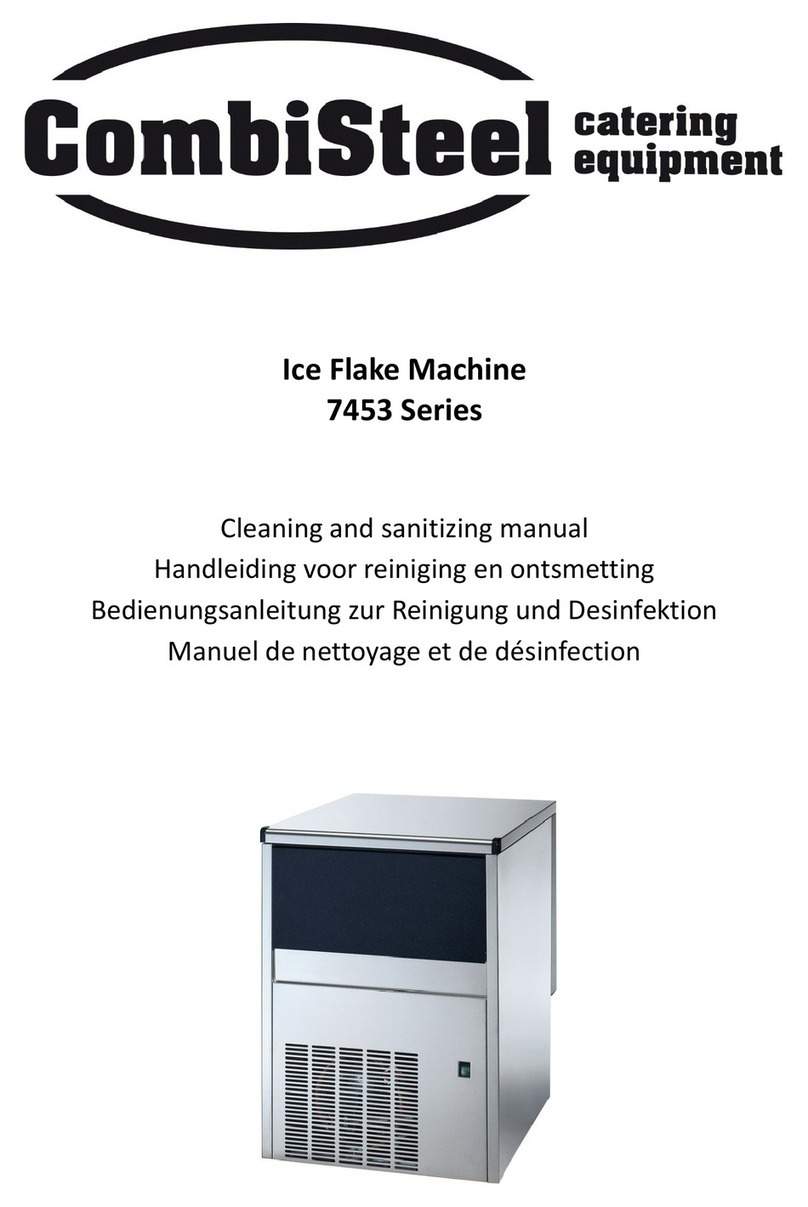BARMATIC ICE20A User manual

User manual
Instrukcja obsługi
ICE CUBE MACHINES
KOSTKARKI DO LODU
You should read this user manual carefully before
using the appliance
Przed uruchomieniem urządzenia należy koniecznie
dokładnie przeczytać niniejszą instrukcję obsługi
Kod: ICE20A
ICE20W
ICE25A
ICE25W
ICE35A
ICE35W
ICE40A
ICE40W
ICE50A
ICE50AP
ICE50W
ICE70A
ICE70W
ICE90A
ICE90W

2
Keep this manual with the appliance.
Zachowaj instrukcję urządzenia.
For indoor use only.
Do użytku wewnątrz pomieszczeń.
CONTENTS
1. SAFETY REGULATIONS ..............................................4
2.
FOREWORD ....................................................... 7
3.
OPERATION....................................................... 7
4. ACTIVATING THE MACHINE .......................................9
5.
MALFUNCTION ................................................ 10
6. CLEANING AND MAINTENANCE...............................11

3
NOTE:
all devices that require a steady connection to water mains (including this device) must be
connected to a water softener which removes calcium and magnesium compounds from the water. The
water softener
must be used in line with the manufacturer’s recommendations included in instruction
manual.
If a water softener is not connected or is user and/or regenerated incorrectly, the dealer shall not recog-
nise any complaints related to repairs due to lime scale build-up in the device.
The following products are recommended to assure proper regeneration:
•
Salt tablets, 25 kg bag - code: 231265
Water hardness
German degrees
(°dH)
French degrees
(°fH)
mmol/l
Clark
degrees
Water softener
connection
over 24
over 40
over 4.2
over 28
Required
EN
18 - 24
32 - 40
3.2 –4.2
22 - 28
Required
12 - 18
19 –32
2.1 –3.2
13 - 22
Required
4 - 12
7 - 19
0.7 –2.1
5 - 13
Required
under 4
under 7
under 0.7
under 5
Not required

4
Dear Customer,
Thank you for purchasing this BARMATIC appliance. Before using the appliance for the first time, please
read this manual carefully, paying particular attention to the safety regulations outlined below.
1. SAFETY REGULATIONS
•
This appliance is intended for commercial use only and must not be used
for
household use.
•The appliance must only be used for the purpose for which it was intended and
designed. The manufacturer is not liable for any damage caused by incorrect
op-
eration and improper use.
•Keep the appliance and electrical plug away from water and any other liquids. In
the event that the appliance should fall into water, immediately remove plug
fromthe socket and do not use until the appliance has been checked by a certified
tech- nician. Failure to follow these instructions could cause a risk to lives.
•Never attempt to open the casing of the appliance yourself.
•Do not insert any objects in the casing of the appliance.
•Do not touch the plug with wet or damp hands.
EN
•
Danger of electric shock!
Do not attempt to repair the appliance yourself. In case
of malfunctions, repairs are to be conducted by qualified personnel only.
•
Never use a damaged appliance!
Disconnect the appliance from the electrical
outlet and contact the retailer if it is damaged.
•
Warning!
Do not immerse the electrical parts of the appliance in water or other
liquids. Never hold the appliance under running water.
•
Regularly check the power plug and cord for any damage. If the power plug or power
cord is damaged, it must be replaced by a service agent or similarly qualified
per-
sons in order to avoid danger or injury.
•
Make sure the cord does not come in contact with sharp or hot objects and
keep it away from open fire. To pull the plug out of the socket, always pull on
the plug
and not on the cord.
•
Ensure that the cord (or extension cord) is positioned so that it will not
cause
a trip hazard.
•
Always keep an eye on the appliance when in use.
•
Warning!
As long as the plug is in the socket the appliance is connected to the
power source.
•
Turn off the appliance before pulling the plug out of the socket.

5
•
Never carry the appliance by the cord.
•
Do not use any extra devices that are not supplied along with the appliance.
•
Only connect the appliance to an electrical outlet with the voltage and
frequency
mentioned on the appliance label.
•
Connect the power plug to an easily accessible electrical outlet so that in case
of emergency the appliance can be unplugged immediately. To completely
switch off the appliance pull the power plug out of the electrical outlet.
•
Always turn the appliance off before disconnecting the plug.
•
Never use accessories other than those recommended by the manufacturer.
Failure
to do so could pose a safety risk to the user and could damage the
appliance. Only
use original parts and accessories.
•
This appliance is not intended for use by persons (including children) with
reduced physical, sensory or mental capabilities, or lack of experience and
knowledge.
•
This appliance must not be used by children under any circumstances.
•
Keep the appliance and its cord out of reach of children.
•
Always disconnect the appliance from the mains if it is left unattended or is not
in
use, and before assembly, disassembly or cleaning.
•
Never leave the appliance unattended during use.
EN
1.1 SPECIAL SAFETY REGULATIONS
•
This appliance is suitable for indoor use only.
•
Place the appliance on a level, stable, horizontal & firm surface with at least 50 mm
spacings for ventilation.
•
WARNING!
Connect to potable water supply only.
•
Danger of electric shock! Never try to open the casing of the appliance yourself.
•
Before using, please check that the mains voltage and frequency match the
infor- mation on the rating label. If this is not the case, do not plug the appliance
into the
socket.
•
Regularly check the power plug and power cord for damage. If the supply cord
is damaged, it must be replaced by the manufacturer, its service agent or
similarly
qualified persons in order to avoid hazard.
•
This appliance is classified as protection class I. This appliance must be
ground- ed. This appliance is equipped with a cord having a grounding wire with
a ground- ing plug. The plug must be plugged into an outlet that is properly
installed and
grounded.

6
•
The equipment contains greenhouse effect fluoride gas governed by the Kyoto
protocol, in quantities indicated on the registration plate. The type of refrigerant
gas present in the refrigeration circuit of the equipment is detailed on the
registra- tion plate (Fig. 10). The GWP (Global Warming Potential) of the HFC
R134a gas is
1430, HFC R404A is 3922.
•
The system is hermetically sealed.
•
The equivalent CO
2
data is displayed on the registration plate.
•
According to Regulation (EC) 1272/2008, gases R134a and R404A are non-
flam- mable and non toxic gases. In different concentrations, they may be
asphyxiating.
Contact with the liquid can cause burns and freezing.
•
The gas in the system is under pressure and may explode if heated.
•
This appliance can be used by children aged from 8 years and above and
persons with reduced physical, sensory or mental capabilities or lack of
experience and knowledge if they have been given supervision or instruction
concerning use of the appliance in a safe way and understand the hazards
involved. Children shall not play with the appliance. Cleaning and user
maintenance shall not be made by
children without supervision.
•
This appliance is intended to be used in household and similar applications such as
EN
1.
staff kitchen areas in shops, office and other working environments;
2.
farm houses and by client hotel, motel and other residential type environments;
3.
bed and breakfast type environments;
4.
catering and similar non-retail applications.
•
Do not store explosive substance such as aerosol cans with a flammable
propel-
lant in this appliance.
•
Connect only to the drinking water mains.
•
Use the new set of mobile junctions (water pipe) supplied with the appliance.
The
old set of junctions must not be reused.
•
Do not start the appliance before the technician intervenes.
1.2 WARRANTY
Any defect affecting the functionality of the ap-
pliance which becomes apparent within one year
after purchase will be repaired by free repair or re-
placement provided the appliance has been used
and maintained in accordance with the
instructions and has not been abused or misused
in any way. Your statutory rights are not affected.
If the appli- ance is claimed under warranty,
state where and
when it was purchased and include proof of pur-
chase (e.g. receipt).
In line with our policy of continuous product
devel- opment we reserve the right to change the
product, packaging and documentation
specifications with-out notice.

7
1.3 DISCARDING & ENVIRONMENT
At the end of the life of the appliance, please
dispose
of the appliance according to the
regulations and guidelines applicable at the time.
Throw packing materials like plastic and boxes in the
appropriate containers.
2. FOREWORD
This appliance (machine) has been designed by
ourtechnical staff and produced in our factory
withdecades of experience and the greatest care
in or-der to achieve the very highest quality
standards. Our ISO 9001 certified quality system
allows us tokeep all company processes under
control, to en-sure continuous improvement of
the quality andsafety of our products.
Read this manual immediately; it will help you to
get to know your machine better. If installed and
used correctly, in accordance with the
instructions, your machine will not present any
risks or hazards for the user.
It is important always to follow the instructions in
this manual.
The user must never access the compressor -
con- denser compartment or tamper with the
control and safety devices in any way.
Read our recommendations for correct use and
optimum application of your ice-making machine
and it will give you troublefree service over a long
working life.
Please always state the model and serial number
of your appliance in all communications with the
manufacturer or our representative.
3. OPERATION
Implement the following operations before
activat-ing the ice maker:
1. Verify that the ice maker has not been damaged
during transport.
2. Remove all the material provided from the con-
tainer: supply pipe, drain pipe, documentation
andany accessories.
3. Clean inside the container with a sponge damp-
ened with warm water and a little sodium bicar-
bonate; rinse with clean water and dry carefully.
4.Place the ice maker in its definite location and
en-sure that it is perfectly level (fig. 1).
Fig. 1
EN

8
Note: When choosing where to install the
appli-ance, make sure that:
-the room temperature never drops below
10°C(50°F) and does not exceed 43°C (110° F)
-the water temperature must be no less than
10°C(50°F) and no more than 32°C (90°F) (fig.
2).
Fig. 2
-the supply water pressure must be no less than
0,1 MPa (1 bar) and no more than 0,5 MPa (5
bar).
Should the pressure exceed 0,5 MPa, install a
pres- sure reducer on the machine water supply
(fig. 3).
5. Install the water connections before the
electricalconnections.
6. Connect the 3/4’’ supply pipe (supplied) to the
machine and to the cold drinking water supply
line.
For practical and safety purposes, it is advisable
to install a shut-off valve (not supplied) (fig. 5:
1. switch; 2. socket; 3. electrical plug; 4.water
sup- ply; 5. valve; 6. water drain from the
condenser: water-cooled version; 7. water drain
from the con- tainer; 8. water drain with open
siphon).
Fig. 5
7. Apply the flexible pipe (supplied) with a 20 mm
EN inner diameter and of adequate length (not more
Fig. 3
- the machine is away from heat sources and in
a
wellventilated area (fig. 4).
Fig. 4
CONNECT ONLY TO THE DRINKING WATER MAINS.
than 1 metre from the machine) to the water
drain fitting of the machine in order to reach the
drain well.
Note: Install the machine in a position that the
ventilation of the cooling unit is not obstructed
in any way (only for air-cooled machines) (fig. 6).
Fig. 6
-Do not install the machine in a dusty room
as the condenser of the cooling unit can be
easily clogged (only for air-cooled machines)
(fig. 6))

9
-If the machine is installed in an area where the
drinking water has a high content of salt solu-
tions, follow the manufacturer’s instructions in
order to minimise the problem.
-To prevent the ice from absorbing bad smells
and
tastes, never store food, bottles, etc. in the con-
tainer.
-Do not leave the ice container door open
duringnormal operation.
3.1 CONNECTING THE APPLIANCE TO THE MAINS
There must be a differential switch (cut-out) in
the electrical system.
If the power supply cable is damaged, it must be
replaced by qualified personnel to prevent any
haz-ards to persons.
4. ACTIVATING THE MACHINE
Implement the following operations before
activat-ing the ice maker.
Note: Implement a minimum inclination of 3% to
the pipes for perfect water flow from the appli-
ance, ensuring that these have no narrowing sec-
tions and are not siphoned. It is advisable that the
pipes drain into an open siphon (fig. 5).
WARNING!: When switching on for the first time
or after a prolonged period without use, after
cleaning the tray in the evaporator area must
be filled with water (Fig. 7). In order to carry
out this operation, lift the cover which prevents
access to the cabinet, slide back the curtain and
pour drinking water into the evaporator tray. For
subsequent cycles this operation will not be nec-
essary.
EN
•Connect the machine to the power supply after
having verified that the mains voltage corre-
spondsto that on the serial number plate on the
rear panel of the appliance.
•The maximum voltage variation tolerance al-
lowed is ±10% of the rated value.
•Provide a power supply circuit to the machine
with its own main switch having an all pole con-
tact separation, that provide a full
disconnection under overvoltage category III
conditions.
•All must be sized according to the amperage
indi-cated on the serial number plate.
•The socket must be easily accessible.
Fig. 7
Fig. 8

10
Once the connections to mains water and elec-
tricity have been checked, open the water supply
tap and insert the plug into the electrical socket.
To finally start the machine, press the illuminated
switch (Fig. 8). It is recommended to not use the
first five cycles of ice. The ice maker is equipped
with a thermostat inside the ice cabinet (Fig. 9),
which stops the machine and the production of
ice when the bulb comes into contact with the ice
ac- cumulated inside the cabinet. Never switch of
the water supply when the machine is on, not
obstructthe air intake ducts.
Fig. 9
Note: After removing ice, free the control bulb
from any ice residue to ensure that ice making
restarts swiftly (Fig. 9).
5. MALFUNCTION
THE FOLLOWING OPERATIONS MUST BE IMPLE-
MENTED SOLELY BY QUALIFIED PERSONNEL.
IN THE EVENT OF MALFUNCTION, IT IS RECOM-
MENDED TO DISCONNECT THE MACHINE FROM
THE ELECTRICAL AND WATER SUPPLY
and check that the leak is not due to
obstructionsin the discharge outlets.
5. If production is insufficient, check that the con-
denser is clean, and check for the presence of
limescale accumulation on the sprayer nozzles.
6. Check that the cabinet sensor is working:
rest-
ing an ice cube on the bulb inside the container
EN 1. Check that the water supply tap is
on.
should stop production within 1 minute, starting
2. Check that power is going to the machine, that
the plug is correctly inserted, and that it is
switched on.
3. Check that there are no abnormal vibrations
caused by loose screws.
4. If intervention is required for water leaks,
tighten- ing screws or otherwise, stop the
machine first
again automatically once the cube is removed in
little more than a minute.
7.
Between summer and winter the cabinet ther-
mometer may vary the maximum quantity of
ice in the cabinet, in order to adjust this value,
contact an authorised installer.
5.1 CUBE ADJUSTMENT
Over time, as a result of variations in ambient
tem- perature, the dimensions and weight of the
cubes may vary.
In order to adjust the size and weight, the adjust-
ment screws on the front, underneath the switch,
can be adjusted (fig.10)
Rotating in a clockwise direction, the weight of
the ice cube increases, and decreases when
rotated in an anticlockwise direction. Doing this
also has an positive or negative effect on the
production time of the ice.

11
Fig. 10

12
6. CLEANING AND MAINTENANCE
THE FOLLOWING OPERATIONS MUST BE IMPLE-
MENTED SOLELY BY QUALIFIED PERSONNEL
Disconnect the electrical power supply from the
appliance to perform maintenance and cleaning
operations.
Use a cloth dampened with a specific chlorine-free
product for stainless steel to clean the structure.
6.1 CLEANING THE AIR CONDENSER
•to make the most of your appliance in terms of
efficiency and durability, the air condenser at
the front of the machine must be cleaned
periodically(vedi fig.11).
•Do not use brushes or blunt objects to clean the
filter.
Fig. 11
EN
6.2 CLEANING THE WATER INLET FILTER
•Close the water shut-off valve of the appliance,
disconnect the water inlet pipe and remove the
filter screen that is on the water inlet
electrovalvewith a pair of pliers.
•Clean the screen with a water jet and
reassembleit into its place.
6.3 CLEANING THE CONTAINER
•Remove the ice from the container. Clean
insidethe container with a sponge dampened
with
warm water and a little sodium bicarbonate.
•Rinse with clean water and dry carefully.
6.4 CLEANING AND SANIFICATION
•The machine has been equipped with a “self
Cleaning” function in order to remedy the prob-
lems deriving from the hardness of the supply
water and therefore, the formation of impurities
on the components and parts that are in
contactwith the water.
•Thanks to the cleaning action of a specific
prod- uct, which comes in the form of powder in
a

11
sachet and a dosing bottle, this function
keeps the
machine clean and sanitised
from limescale and deposits.
•To guarantee proper cleaning of the ice
maker one recommends carrying out the
wash cycle at least 3-4 times a year,
according to the hardness of the water
supply.

12
water;
lly;
ntainer door
ajar.
Cleaning kit (optional)
The kit is composed of a plastic bottle with rubber pipe, one confection of acid citric (1 kg), and instructions
for the cleaning procedure.
Quantities of citric acid to be mixed with water in the bottle to obtain the mixture
MODEL CITRIC ACID Q.TY
20 - 25 Kg 200 g
30 - 40 Kg 250 g
50 Kg 350 g
70 - 90 Kg 500 g
6.5 IMPLEMENTING THE WASH AND SANITATION CYCLE
Adopt proper precautions when handling citric acid
whilst preparing the solution (water + citric acid, see
the table). Wear protective gloves and goggles.
•Turn the machine off.
•Remove all ice from the container.
•Using the specific product and the plastic
bottle, prepare the solution by dissolving the
powder in warm water (max. 40°C), according to
the quanti-
Switch the machine off;
Remove all ice from the
container;Discharge all
Clean carefu
Leave the co
EN ties shown on the attached table. mix well whilst
ensuring that no lumps are formed.
•Position the internal switch in the cleaning posi-
tion (Fig. 12)
•Pour the cleaning product into the evaporator
tray(Fig. 13)
•Turn the power to the machine on and wait for
atleast 2 hours.
•After two hours, switch the machine off and
drain the solution in the evaporator tray into the
cabinet(Fig. 14).
•Replace the cap and pour clean water into the
tray of a quantity equal to its capacity, and start
the machine again.
•Repeat the operation at least 5 times to
eliminate the presence of limescale remover and
sanitiser.
•After this time has elapsed, switch the machine
off and remove the cap to discharge the water
inthe evaporator tray, then replace the cap.
•Finally, return the switch to ice mode.
•After the cleaning function, rinse the cabinet well.
•If the apparatus remains unused for long periods:
Fig. 12
Fig. 13
Fig. 14

13
WARRANTY
Any defect affecting the functionality of the appli-
ance that becomes apparent within one year after
purchase will be corrected by free repair or
replace- ment provided the appliance has been
used and maintained in accordance with the
instructions and has not been abused or misused
in any way. Your statutory rights are not
affected. If the appliance is claimed under
warranty, state where and when
it was bought and include proof of purchase (f.e.
receipt).
In line with our policy of continuous product
devel- opment we reserve the right to change the
product, packaging and documentation
specifications with-out notice.
DISCARDING & ENVIRONMENT
When decommissioning the appliance, the prod-
uct must not be disposed of with other household
waste. Instead, it is your responsibility to dispose
to your waste equipment by handing it over to a
designated collection point. Failure to follow this
rule may be penalized in accordance with applica-
ble regulations on waste disposal. The separate
collection and recycling of your waste equipment
at the time of disposal will help conserve
natural
resources and ensure that it is recycled in a
manner that protects human health and the
environment. For more information about where
you can drop off your waste for recycling, please
contact your local waste collection company. The
manufacturers and importers do not take
responsibility for recycling, treatment and
ecological disposal, either directly or through a
public system.
EN

14
PL
SPIS TREŚCI
1.
ZASADY BEZPIECZEŃSTWA ...................................................16
2.
WSTĘP.......................................................................... 19
3.
INSTALACJA ................................................................ 20
4.
URUCHOMIENIE........................................................... 22
5.
NIEPRAWIDŁOWE DZIAŁANIE.................................................23
6.
CZYSZCZENIE I KONSERWACJA............................................24

15
UWAGA: wszystkie urządzenia wymagające stałego podłączenia do sieci wodnej (między innymi
niniejsze
urządzenie) koniecznie muszą mieć podłączony dodatkowo zmiękczacz wody usuwający z niej
związki wapnia i magnezu. Zmiękczacz musi być użytkowany zgodnie z zaleceniami producenta zawartymi w
instrukcji obsługi.
W przypadku braku podłączenia zmiękczacza lub jego złego użytkowania i/lub regeneracji dystrybutor
nie będzie uznawać reklamacji związanych z naprawami wynikającymi z zakamienienia urządzenia.
Zaleca się stosowanie zmiękczaczy z bogatej oferty BARMATIC:
W odpowiednim doborze konkretnego modelu pomoże
Ci przedstawiciel handlowy firmy BARMATIC
Do prawidłowej regeneracji zmiękczaczy zalecamy:
Tabletki solne, worek 25 kg –kod: 231265
PL
Twardość wody
Stopnie niemieckie
(°dH)
Stopnie francuskie
(°fH)
mmol/l
Stopnie
Clarka
Podłączenie
zmiękczacza
powyżej 24
powyżej 40
powyżej 4,2
powyżej 28
Konieczne
18 - 24
32 - 40
3,2 –4,2
22 - 28
Konieczne
12 - 18
19 –32
2,1 –3,2
13 - 22
Konieczne
4 - 12
7 - 19
0,7 –2,1
5 - 13
Konieczne
poniżej 4
poniżej 7
poniżej 0,7
poniżej 5
Niewymagane

16
Szanowni Klienci,
Dziękujemy za zakup urządzenia marki BARMATIC. Przed użyciem urządzenia po raz pierwszy, przeczytaj
dokładnie instrukcje obsługi, zwracając szczególną uwagę na część dotyczącą zasad bezpieczeństwa,
która znajduje się w poniższym punkcie.
1. ZASADY BEZPIECZEŃSTWA
•
Nieprawidłowa obsługa i niewłaściwe użytkowanie mogą spowodować
poważne
uszkodzenie urządzenia lub zranienie osób.
•
Niniejsze
urządzenie
przeznaczone
jest
wyłącznie
do
użytku
komercyjnego
i nie może być stosowane do użytku domowego.
•
Urządzenie należy stosować wyłącznie zgodnie z przeznaczeniem.
Producent nie ponosi żadnej odpowiedzialności za szkody spowodowane
nieprawidłową ob-
sługą i niewłaściwym użytkowaniem urządzenia.
•
W czasie użytkowania zabezpiecz urządzenie i wtyczkę kabla zasilającego
przed kontaktem z wodą lub innymi płynami. W mało prawdopodobnym
przypadku zanurzenia urządzenia w wodzie, należy natychmiast wyciągnąć
wtyczkę z kon- taktu, a następnie zlecić kontrolęurządzenia specjaliście.
Nieprzestrzeganie tej
PL
instrukcji może spowodować zagrożenie życia.
•
Nigdy nie otwieraj samodzielnie obudowy urządzenia.
•
Nie wtykaj żadnych przedmiotów w obudowę urządzenia.
•
Nie dotykaj wtyczki kabla zasilającego wilgotnymi rękami.
•
Niebezpieczeństwo porażenia prądem!
Nie należy samodzielnie naprawiać urzą-
dzenia. Wszelkie usterki i niesprawności winny być usuwane wyłącznie przez
wy-
kwalifikowany personel.
•
Nigdy nie używać uszkodzonego urządzenia!
Uszkodzone urządzenie należy
odłączyć od sieci i skontaktować się ze sprzedawcą.
•
Ostrzeżenie!
Nie zanurzać części elektrycznych urządzenia w wodzie ani w in-
nych płynach. Nie wkładać urządzenia pod bieżącą wodę.
•
Regularnie sprawdzać wtyczkę i kabel zasilający pod kątem uszkodzeń. Uszko-
dzoną wtyczkę lub kabel przekazać w celu naprawy do punktu serwisowego lub
innej wykwalifikowanej osoby, aby zapobiec ewentualnym zagrożeniom i
obraże-
niom ciała.
•
Upewnić się, czy przewód zasilający nie styka się z ostrymi ani gorącymi przedmio-
tami; trzymać kabel z dala od otwartego płomienia. Aby wyjąć wtyczkę z gniazdka,
zawsze ciągnąć za wtyczkę, a nie za kabel.

17
•
Zabezpieczyć przewód zasilający (lub przedłużacz) przed przypadkowym
wycią- gnięciem z kontaktu. Przewód poprowadzić w sposób uniemożliwiający
przypad-
kowe potknięcie.
•
Stale nadzorować urządzenie podczas użytkowania.
•
Ostrzeżenie!
Jeżeli wtyczka jest włożona do gniazdka, urządzenie należy
uważać
za podłączone do zasilania.
•
Przed wyjęciem wtyczki z gniazdka wyłączyć urządzenie!
•
Nigdy nie przenosić urządzenia, trzymając za kabel.
•
Nie używaćżadnych akcesoriów, które niezostały dostarczone wraz zurządzeniem.
•
Urządzenie należy podłączać wyłącznie do gniazdka o napięciu i częstotliwości
podanych na tabliczce znamionowej.
•
Włożyć wtyczkę do gniazdka zlokalizowanego w dogodnym łatwo dostępnym miej-
scu, tak by w przypadku awarii istniała możliwość natychmiastowego
odłączenia urządzenia. W celu całkowitego wyłączenia urządzenia odłączyć je
od źródła za- silania. W tym celu wyjąć z gniazdka wtyczkę znajdującą się na
końcu przewodu
odłączanego urządzenia.
•
Przed odłączeniem wtyczki zawsze pamiętać o wyłączeniu urządzenia!
•
Nie korzystać z akcesoriów niezalecanych przez producenta. Zastosowanie nie-
zalecanych akcesoriów może stwarzać zagrożenie dla użytkownika oraz
pro-
PL
wadzić do uszkodzenia urządzenia. Korzystać wyłącznie z oryginalnych części i
akcesoriów.
•
Z urządzenia nie mogą korzystać osoby (także dzieci), u których stwierdzono
osła- bione zdolności fizyczne, sensoryczne lub umysłowe, albo którym brakuje
odpo-
wiedniej wiedzy i doświadczenia.
•
W żadnym wypadku nie zezwalać na obsługę urządzenia przez dzieci.
•
Urządzenie wraz z przewodem przechowywać poza zasięgiem dzieci.
•
Nie dopuścić, by dzieci wykorzystywały urządzenie do zabawy.
•
Zawsze odłączyć urządzenie od zasilania, jeżeli ma być ono pozostawione bez
nadzoru, a także przed montażem, demontażem i czyszczeniem.
•
Nie zostawiać urządzenia bez nadzoru podczas użytkowania.

18
1.1 SZCZEGÓLNE PRZEPISY BEZPIECZEŃSTWA
•
Sprzęt zawiera fluorowane gazy cieplarniane w ilości określonej na tabliczce
zna-mionowej i dopuszczalnej na mocy protokołu z Kioto.
•
Specyfikacja gazu chłodniczego wykorzystanego w obiegu chłodniczym
urządze- nia określona została na tabliczce znamionowej (Rys. 10). Potencjał
tworzenia efektu cieplarnianego (GWP) dla gazu HFC R134a wynosi 1430, dla
czynnika HFC
R404A - 3922.
•
System jest zamknięty hermetycznie.
•
Dane dotyczące równoważnika CO
2
znajdują się na tabliczce znamionowej
•
Zgodnie z Rozporządzeniem Parlamentu Europejskiego i Rady (WE) nr
1272/2008,
gazy R134a oraz R404A nie są łatwopalne ani toksyczne. W
innych stęże-
niach mogą być duszące. Kontakt z cieczą może powodować
oparzenia bądź
odmrożenia.
•
Gaz w systemie chłodniczym znajduje się pod ciśnieniem i w wyniku nagrzania
może spowodować wybuch.
•
Z urządzenia mogą korzystać dzieci w wieku 8 lat oraz powyżej 8 lat, jak
również osoby o obniżonej sprawności ruchowej, czuciowej lub psychicznej lub
osoby nie-
PL
posiadające doświadczenia i odpowiedniej wiedzy, o ile korzystają z urządzenia
pod opieką innych lub zostały poinstruowane w kwestii korzystania z
urządzenia w sposób bezpieczny, jak również pod warunkiem, że mają
świadomość zagro- żeń związanych z użytkowaniem urządzenia. Nie dopuścić,
by dzieci wykorzysty- wały urządzenie do zabawy. Zabrania się wykonywania
przez dzieci czynności związanych z czyszczeniem i konserwacją urządzenia,
jeśli nie znajdują się pod
nadzorem osób dorosłych.
•
Urządzenie przeznaczone jest do użytku w gospodarstwach domowych oraz w na-
stępujących miejscach:
1.
kuchnie dla pracowników w sklepach, biurach oraz innych środowiskach pracy;
2.
gospodarstwa rolne, kuchnie przeznaczone do użytku gości w
hotelach,motelach oraz innych obszarach mieszkalnych;
3.
hotele typu „bed and breakfast”;
4.
placówki oferujące usługi gastronomiczne oraz podobne instytucje
zajmujące
się handlem niedetalicznym.
•
Nie składować substancji wybuchowych, np. pojemników z aerozolem wraz z
ła-
twopalnym gazem znajdującym się w urządzeniu.
•
Urządzenie podłączać wyłącznie do źródła wody pitnej.
•
W tym celu użyć nowego zestawu ruchomych złączek (wąż do wody)
This manual suits for next models
14
Table of contents
Languages:
Other BARMATIC Ice Maker manuals



